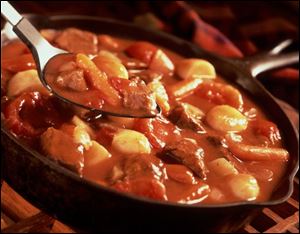
Mothers, others are warming up to cookware
5/7/2002Whether you are a bride-to-be registered for gifts at a local cookware store or a mom who wants to upgrade what's in the cupboard, a whole world of cookware is begging for your attention.
Many brands have high-profile chefs touting their benefits.
But don't despair if you don't have any matching pans in your kitchen. One of my food journalist colleagues commented last week at a seminar that she has assorted brands of pans - each for a specific purpose - and that she wouldn't want a matching set.

Cast-iron frypans often are preseasoned to prevent rust.
If cookware is on your list for giving or receiving on Mother's Day, it helps to know some common cookware terms. Here are some from the Cookware Manufacturers Association.
Specific use of cookware may determine the pieces you choose.
Sauces and stews belong in more cylindrical pots where the element's heat can be cycled throughout the food. Quickly cooked items and those needing sauteing are prepared in skillets and saute pans.
Some recipes require specific pans. For example, bundt cake recipes should be baked in fluted tube cake pans; angel food cakes in angel food cake pans. Roasters are designed for turkeys, hams, or big pieces of meat meant for your oven, not your stovetop.
Small one to two-quart saucepans are perfect for couples. As a family grows, four-quart Dutch ovens may be needed.
Some designs help solve the problem of boil-overs by making the cover flat with a recessed well to hold any escaping liquid.
Pasta inserts are colanders in stockpots or Dutch ovens to simplify preparation. When the pasta is done, the insert is lifted from the pan and placed in the sink to drain. Inserts and pans are also available for steaming vegetables and seafood, and for poaching fish.
Kathie Smith is The Blade's food editor. E-mail her at food@theblade.com.